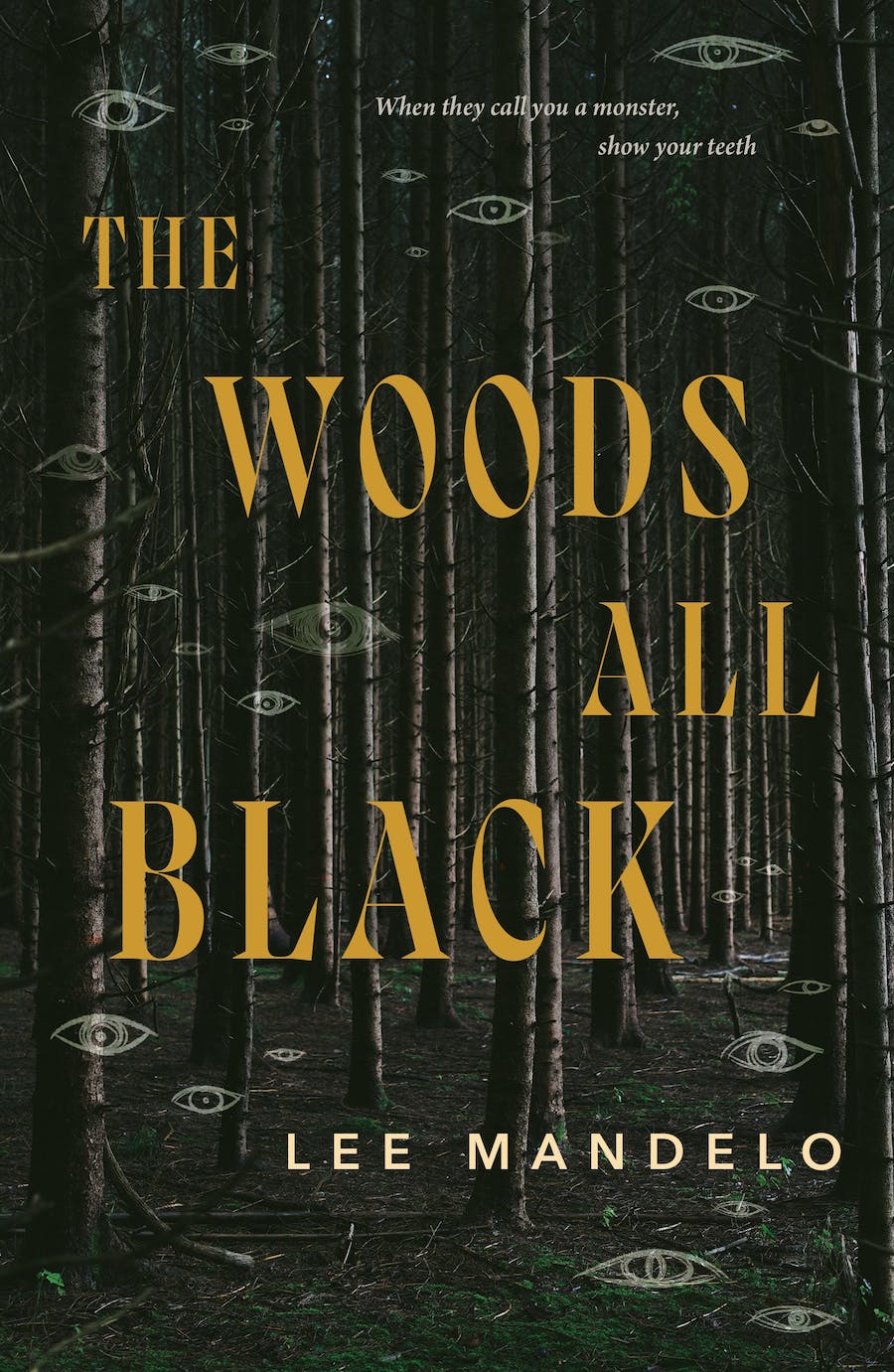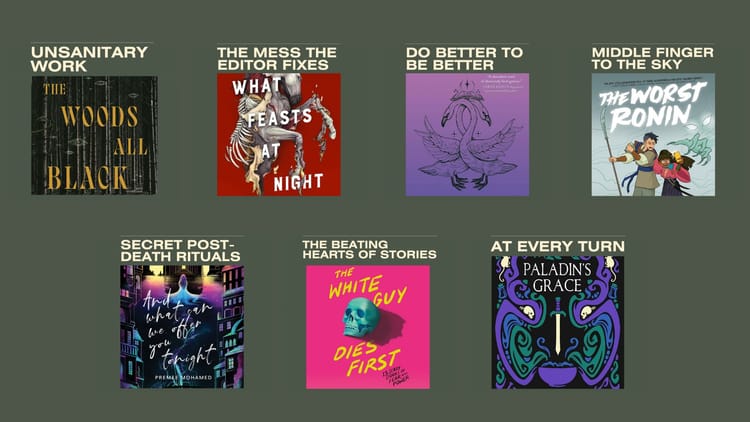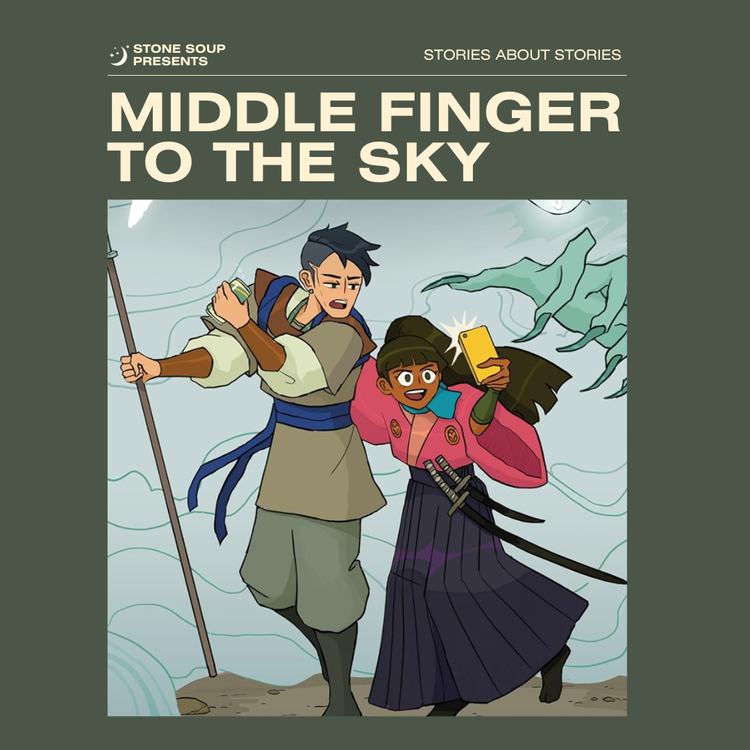Unsanitary Work: The Woods All Black by Lee Mandelo

The Woods All Black exists thanks to the brilliant storytelling mind of Lee Mandelo – and, just like every book that’s on your bookshelf, it’s the product of an immense collaborative effort by a team of publishing experts. This year’s Stone Soup series, Stories About Stories, aims to shine a spotlight on that collaboration. To kick us off, I climbed into the inboxes of the team behind The Woods All Black to learn more about how this brutal and complex book came to be.
The Woods All Black is equal parts historical horror, trans romance, and blood-soaked revenge, all set in 1920s Appalachia. Leslie Bruin is assigned to the backwoods township of Spar Creek by the Frontier Nursing Service, under its usual mandate: vaccinate the flock, birth babies, and weather the judgements of churchy locals who look at him and see a failed woman. Forged in the fires of the Western Front and reborn in the cafes of Paris, Leslie believes he can handle whatever is thrown at him—but Spar Creek holds a darkness beyond his nightmares.
Something ugly festers within the local congregation, and its malice has focused on a young person they insist is an unruly tomboy who must be brought to heel. Violence is bubbling when Leslie arrives, ready to spill over, and he'll have to act fast if he intends to be of use. But the hills enfolding Spar Creek have a mind of their own, and the woods are haunted in ways Leslie does not understand.
The Woods All Black is a story of passion, prejudice, and power — an Appalachian period piece that explores reproductive justice and bodily autonomy, the terrors of small-town religiosity, and the necessity of fighting tooth and claw to live as who you truly are.
Ed. note: This interview has been edited for clarity and flow.

Gailey: How did The Woods All Black come together?
Lee Mandelo, Writer & Scholar, author of The Woods All Black: I initially proposed [The Woods All Black] with the sale of Summer Sons in 2020, but ended up pushing the drafting itself out until 2022.
Gailey: What made you decide to push it back?
Mandelo: Partly pandemic stress, which led to me writing Feed Them Silence instead, but partly just... the difficulty of historical research (so much material!) and the emotional strain of writing about trans, queer, and reproductive liberation in a time of increasing global fascist and far-right pressure.

Carl Engle-Laird, Senior Editor, Tor Publishing Group: The Woods All Black came to me in a different condition than what readers will pick up when the book releases. I worked with Mandelo to refine his story, first helping him shape the narrative at a structural level and then moving on to line-by-line improvements.
Gailey: What kind of refinements were you looking at?
Engle-Laird: [It came to me with] a different title, a different ending, and a lot of other differences both subtle and profound. It struck me immediately as a book with strong, compelling characters, a deliciously horny energy, and real problems with pacing and plotting that we'd have to work out.
Mandelo: Between Carl’s patience when I simply did not turn in this novella for an additional two years and his excellent editorial guidance on the heinously messy zero draft, he made this book shine. The end result was a project that had its teeth bared, metaphorically and literally, way more than the initial proposal thought it would.
Gailey: It sounds like there was a significant lift involved at the editing stage as well as the drafting stage.
Engle-Laird: Luckily, it was my third book with Lee, and by that point we'd established our professional relationship. I knew Lee would respond well to my critiques and be able to bring out the best version of the book. And as always, every aspect of my job was easier thanks to my assistant Matt Rusin!

Gailey: Matt, what was your first impression of Woods All Black?
Matt Rusin, Assistant Editor, Tor Publishing Group: From first glance, I knew that Lee had done it again. He is one of the finest writers of atmosphere and tone I know, and I was so excited to delve deep into the dark Appalachian wilds with him. He did not disappoint. Lee really manages to walk the line here between horror and deep emotional drama in a way that is murderously satisfying.
Gailey: Can you share a little bit about how you work with Carl on books like this one?
Rusin: I'm an assistant editor, which means that I wear two hats. While I am an editor in my own right--meaning I can acquire and edit books on my own--I also assist senior-level editors with their lists. (If you didn't know, a "list" is the term used in the "biz" for all the books an editor has acquired). My work on this one was mostly behind the scenes. The majority of my responsibilities involve ensuring that various documents and data get where they need to be and are seen by who needs to see them. Publishing a book involves many steps, and unlike digital content that can easily be revised, once a book is printed it takes a long time to update it or correct any mistakes. It's for that reason that we go through many rounds of quality checks for each step of the process.

Gailey: Speaking of many rounds of quality checks, developmental and line-level editing aren’t the end of the line for the editorial process on a book like this one.
Dakota Griffin, Production Editor, Tor Publishing Group: I’m the book’s production editor, one of the less often discussed publishing jobs. I hire the copyeditors and proofreaders, who are freelancers, and review the changes they and the author make. I was lucky to have a team that was really enthusiastic about this story: Copyeditor Christina MacDonald, proofreader Melanie Sanders, and cold reader Winn Foreman. I couldn’t do my job without their careful reading and thoughtful notes.
Gailey: What’s your perspective on your team’s role in the editorial process?
Griffin: At this point in the process, we're focused mostly on clarity, consistency, and continuity, putting that final polish on a book. I copyedit anything new the author adds to ensure we're not introducing errors or deviating from the text's consistent internal style. There’s a sort of cultural myth about copyeditors and proofreaders being people who are trying to “correct” writing or force it into perfect accordance with a given style guide, but I don’t buy into that.
Gailey: If “correcting” the book isn’t the priority, what is?
Griffin: Something that’s always important to me, but was especially so here given the crucial sense of time and place in the language, is making sure that any suggested changes serve the story and don’t sand away its character in the name of grammar, which is a thing, not unlike gender, that we’ve kind of made up anyway. Lee is so great at building a narrative voice that matches the story, and I was really excited to be able to help make it shine.
Gailey: It sounds like ultimately, you view your work as a process of supporting the author’s vision.
Griffin: The way I see it, good copyediting and proofreading is about paying serious, detailed attention to the text; trying to internalize the author’s style so you can make suggestions that serve it; and asking good questions. You’re holding up a mirror–one of those magnifying makeup table mirrors, really–to the text and asking the author if they like what they see, offering them a last chance to adjust the details before they send their book off into the world.
Gailey: That work must require so much investment in the ethos of the project. When did you start developing that investment for this book?
Griffin: For the most part, production editors hear about books for the first time when the editors formally present them at our launch meetings. Those meetings are my professional equivalent of flipping through the Toys “R” Us holiday catalog as a kid: I get to hear about everything we're publishing in a four-month season and make a little wish list of the books I want to work on.
Gailey: And this one went on the wish list right away?
Griffin: I've been a big fan of Lee's writing since Summer Sons, and I was the production editor on his last novella, Feed Them Silence, so I had penciled in The Woods All Black on my wish list before Carl even started talking, but when I heard the pitch? Underlined, circled, excessive exclamation points. I had to work on this book! You're telling me that Lee's doing historical fiction? Lee, with his talent for writing settings so rich and textured that you would swear you’d really been there and his queer characters who are so often haunted, messy, and rough around the edges in the best, most true-to-life way? I was sold, sold, sold.
Gailey: The decision to publish a book is, for the publisher, a decision to generate a massive amount of internal enthusiasm and support for the title. How do you go about building that support?
Engle-Laird: In the end, the story came together beautifully. We gave the text over to production, and my focus shifted to presenting and packaging it for the sales force. As the primary editor for The Woods All Black, I served as the point of contact between the book and every other department that worked on it. [I was responsible for] communicating to art while they made a cover, to marketing and publicity, and to sales as they prepared to present the book to our retail partners.

Libby Collins, Senior Publicist, Macmillan Publishers / Tor Publishing Group: [Carl’s] excitement for this book was obvious and it started early in the process. I've been working with Lee for a few years now, so I know that basically anything he writes is going to be incredible. This book is historical fiction, while Lee's first two were contemporary and near-future, respectively. Once I heard the premise of this book, I was very excited about the many new publicity possibilities.
Gailey: What kind of possibilities got you excited?
Collins: There's a wide readership for historical fiction, and I'm convinced that those readers are hungry for the stories that have historically been left out of the conversation. So I’m excited to see how this book--which features real historical references to the Frontier Nursing Service by way of a trans nurse who's looking to not only provide the usual fare of vaccinations and safe pregnancies, but also life-saving and affirming care for those in the community who don't have the freedom to voice their true health concerns--resonates with those same historical fiction readers.
Gailey: It’s absolutely true that this book brings a revolutionary queer lens to the genre.
Engle-Laird: I love editing queer fiction, and my goal is always to protect the author from any force that would sand down their unique edges. Lee Mandelo has sharp edges, and this book will leave you bloody. It's a book about murdering everyone who ever deadnamed you and then vanishing into your real gender.
Gailey: It’s so important to keep those edges alive.
Engle-Laird: In a media landscape that wants to sanitizes queer fiction to please a broader audience, I'm happy to keep editing and publishing unsanitary work.
Mandelo: I'm proud of the sex scenes, because I think they're both horny as hell *and* doing a lot of heavy lifting with the different ways gender, embodiment, and desire are being worked out real-time between the protagonists.
Engle-Laird: I'm proud of us for keeping the book freaky! Do you think more people will read it if I promise them werepanther chode? I haven't been on social media in a while.
Gailey: Speaking of which, let’s get into the package. (By which I mean the exterior of the book, of course.)
Rusin: Christine Foltzer designed an incredible cover!
Mandelo: I *love* the cover, Tordotcom never fucking misses with these covers.
Gailey: Christine, can you introduce yourself and your work?
Christine Foltzer, Art Director, Tordotcom Publishing/Tor Publishing Group: I manage the book cover design and production. I collaborate with the editor and any freelance creatives to find the right visual images to give the book cover that best describes the book both in terms of story but also in terms of tone and mood. In this case I designed the cover myself so I was the only visual creative on this book cover.

Gailey: What was your process for Woods All Black?
Foltzer: I got a cover memo from [Carl Engle-Laird] and discussed with him the visual elements that best described the book. I also read it myself to get a better feel for it. The editor and I decided this felt more like a designed cover than a traditionally illustrated one. Because I loved the manuscript so much I decided to take on the design for this one personally.
Gailey: Is there anything you’re especially pleased with in the final design you landed on?
Foltzer: I love that I was able to include the drawn little eyes through the cover. I drew those myself. They weren't difficult but they were fun to do. I also really love the title font. It felt both contemporary and vintage.
Gailey: Other than the art and title treatment, what else goes into the design of the outside of the book?
Griffin: Copyediting and proofreading the jacket or cover and helping guarantee the book stays on schedule are part of my job.
Rusin: I have a hand in the crafting of the copy that goes on the back cover or jacket flaps, cover design ideas, title and tagline creation, etc.
Engle-Laird: We went through a tagline process twice! Our first tagline was about woods being full of eyes, and it was so good that it became the cover concept. However, once the cover showed a wood full of eyes, we had to go back to the drawing board. I like our second take better: it gets to the heart of the story, promising the monstrous defiance that our audience hungers for.

Gailey: Once the interior and exterior of the book are designed and ready to go, the book has to get out into the world. How does it start getting in front of readers?
Collins: My job as publicist is to strategically send [advance copies of the book] out to trade publications, members of the media, etc. for review, feature, interview, and roundup coverage. During this time, I'm also pitching a wider list of contacts in the hopes of building as much buzz as possible for this very buzzworthy book. As we get closer to publication, I create a press release for the book and start pitching an even wider list of contacts (including book bloggers and social media influencers), and send finished copies out to those folks to really build the buzz in the final 4-6 weeks leading up to publication.
Gailey: Have you seen a strong response so far?
Collins: I'm proud of the excitement that's been building for this book nice and early. As I mentioned, Lee Mandelo has solidified himself as a writer to watch, and someone who's guaranteed to tell complex, smart, often heartbreaking stories of queer desire and existence. He's earned himself a solid fanbase who now await his next projects with bated breath, so it's been exciting to watch that build upon itself.
Gailey: This effort to get the book out there comes with a big administrative lift, too.
Rusin: Something I'm particularly proud of is my efforts to maintain The Woods All Black content in our externally-feeding database. The copy, tagline, and metadata for this title went through several iterations and it was my responsibility to ensure that we were using the most up-to-date versions on sites like Barnes and Noble, Amazon, Kobo, Macmillan.com, etc.
Gailey: Thank you so much for providing this window into the immense amount of teamwork that goes into the making of a book.
Engle-Laird: Once an editor finishes with the text, we have to let the book move on into the care of others. Thankfully, with this team I never had to worry. It's an honor to work with colleagues as committed and passionate about the work as I am.
Mandelo: I couldn't have made it down the long road from the first proposal in 2020 to the completed, ready-for-readers novella in 2024 without a supportive (and patient!) production team. While I work most closely with Carl and Matt through the editorial process, and then Libby as my publicist once the book meets the world, I'm always aware of how many hands are on the project behind the scenes. The eye-catching (hah) cover design and the interior layouts, the marketing outreach and social media posting, all of it is vital to the success of the project—and I'm so grateful!
Griffin: Something I love in the final product (but had very little to do with) is the bibliography in the acknowledgments. This story is fiction, but it’s informed by so much real history. A lot of people have spent a lot of time trying to sell the lie that queerness and especially transness is new, that it’s a fad. This book reminds us that’s not true, and the bibliography says, “I’m serious, and you can read the history for yourself. You can read stories about us and written by us, published before today’s bigots were even born. We’ve always been here. And we’re not going anywhere.”
Pre-order The Woods All Black
The Woods All Black releases on March 19, 2024. Pre-order it now from your favorite retailer.
Bookshop.org | Barnes & Noble | Bad River Website | Local Library | Find an Indie Bookstore






Member discussion